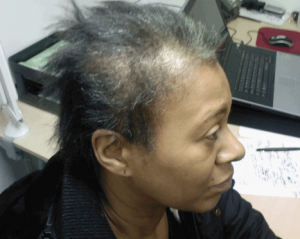(Akiit.com) Hair has historically always been a contentious issue of beauty and self-identity. From the covering of hair for religious reasons, to the expression of rebellion through the hairstyles of the youth, to the infamous ‘pencil test’ despicably used all those years ago, by the Apartheid regime in South Africa to inform racial categorization. Hair is more than just a part of our anatomy, it is a physical expression of identity and societal perception of beauty. So, when you are inflicted with the irresistible urge to pull out your own hair, the consequences are far deeper than simply aesthetic. The disorder is known as Trichotillomania (TTM), and a 2013 study reports that it is estimated between 0.6% and 4.0% of the overall population, and 1% in the United States will have experienced this disorder in their lifetime. This means that approximately 2.5 million Americans may be affected by Trichotillomania at some point in their lives. That is quite a significant prevalence for a largely little known psychological disorder.
What is Trichotillomania?
One of the reasons TTM is so little known is because it is often  perceived as just a bad habit. It is true that many people twirl, play or even pull out their hair habitually with no physical or emotional consequences. One of the key clues that behaviour may have a clinical component is if it impacts negatively on your functioning and your ability to engage in meaningful occupations or negatively affects your relationships. Some of the warning signs that hair pulling is affecting your function include:
perceived as just a bad habit. It is true that many people twirl, play or even pull out their hair habitually with no physical or emotional consequences. One of the key clues that behaviour may have a clinical component is if it impacts negatively on your functioning and your ability to engage in meaningful occupations or negatively affects your relationships. Some of the warning signs that hair pulling is affecting your function include:
- Not being able to go out in public without covering up the pulling site, e.g. wearing hats, scarves, sunglasses
- Avoidance of social situations when conditions are windy or wet, e.g. swimming
- Constantly being late due to spending extended periods of time pulling
- Feeling you are not in control of the ability to stop pulling
Age of onset, gender distribution and race
Studies show that the age of onset for trichotillomania is variable, with a mean age of onset between 9 and 13 years of age, and a peak prevalence at 12-13 years. Although trichotillomania seems to be more common in children than adults, severity of presentation appears to be higher in adolescence and prognosis becoming poorer as onset age approaches adulthood. The literature purports that there is an equal distribution of trichotillomania incidence between the sexes among preschool-aged children, whereas a staggering 70-93% of preadolescents and young adults are female. A 2007 article in the American Journal of psychiatry reports that females tend to outnumber males by 3 to 1 among adults, with the Diagnostic and Statistical Manual (DSM-5) citing an overall female predominance of 10 to 1. Currently there are no studies reporting differences in the prevalence of trichotillomania between different racial groups.
Trichotillomania Treatment
Currently there is not definitive cure for Trichotillomania, with it being considered a chronic psychological condition. However, there are numerous treatment options available. Cognitive behavioral therapy has been shown to be the most effective form of treatment for long-term results, but it is important for those with TTM to recognize that not all treatments work for everyone and that a holistic approach is often the best approach.
Alternative therapies like hypnosis, pharmacological treatments and natural health remedies, and traditional talk therapies all have a place in the treatment of compulsive hair pulling. The first step however, is recognizing you have a problem and sharing your struggles with someone who can support you. Support, whether professional or personal is ultimately the cornerstone of recovery for anyone suffering from Trichotillomania. For more information about TTM you can visit www.trichstop.com/blog.
Staff Writer; Shelia Hall









Leave a Reply